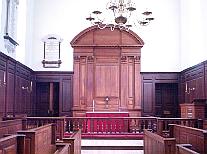 Those clever fellows in the MSM never miss an opportunity to put a little kink in their news
Those clever fellows in the MSM never miss an opportunity to put a little kink in their news The story concerns the continuing saga of the cross in Wren Chapel at William and Mary. Here’s how WAPO headlines the article:
School’s Move Toward Inclusion Creates a Rift
The article goes on to discuss the continuing controversy regarding the use of the cross at Wren Chapel, a story that has been going on since October, with no sign of abating. Back then, Gates of Vienna called it “Away in a Closet”, since that was what the
The Post does give the URL for Save The Wren Cross, which has become the clearinghouse for this contretemps, one which will not go away, despite the college administration’s efforts to make it disappear.
[By the way, the author of the original outrage and energy to make President Nichol take back his command of removal was the future Baron’s roommate, Will Coggins. It was he who raised the alarm and started the backlash. World Net Daily gave him a mention in a recent story but I don’t think anyone realizes that this is really his doing. Fortunately, others, like Vince Haley of the American Enterprise Institute, took the ball and ran with it. But Will, one of the few libertarians at William and Mary with the courage to come out of the closet, deserves recognition for what he initiated.]
Just to bring you up to date:
In October, President Nichol, without any prior announcement to the college community, ordered the removal of the cross from its accustomed place on the altar. It was to be stored in a closet and left there except for those times when it was specifically requested. YouTube ran a widely viewed video of the removal.
As people noticed the bare altar and the news trickled out into the college community, there was a backlash of protest, not only about Nichol’s order but also about the way in which it was accomplished. Perhaps he thought no one would notice? Or that the passive student body would simply shrug and move on? Or that the alumni, far removed, would be indifferent?
- - - - - - - - - -
Wrong. First the students reacted, and then the word spread. President Nichol stood his ground, claiming that some of those who used the Chapel found the cross offensive. I believe he’s been able to produce only one complaint so far. There are now over seven thousand registered complaints about his sudden and secretive decision to remove this offensive religious icon.
Now the president has decided, in yet another fiat — which he labels a compromise — that the Cross will be returned to its place on Sundays, and that a plaque will be put up explaining the history of the cross. A very Anglican move, I should say. Anglican churches are full of plaques, and Wren Chapel began life as an Anglican church.
Note that the “compromise” is designed and carried out by Nichol, without input from the college community. Poor Nichol. He doesn’t seem to have grasped the ideas behind discussion, collegial decision-making, or compromise. Obviously, he just wants the whole thing to go away, and the only trick in his repertoire is giving orders.
In any other state school he might have succeeded. But William and Mary is so steeped in tradition they probably have Thomas Jefferson’s fingernail clippings in a reliquary somewhere. And the center and soul of that tradition is Wren Chapel: everything of any importance happens there. In fact, the Baron was initiated into Phi Beta Kappa in Wren Chapel, as was his mother before him. Phi Beta Kappa itself began there. As more than one person has said, William and Mary is the only state school that seems like a private university. Oh, and that’s another thing: it will never deign to use the term “university.” It began as The College of William and Mary, and thus will it remain.
It was a state school begun by the Anglican Church to train clergy and scholars back when the Anglican religion was the state religion of Virginia, back when the Episcopal church was called the Church of Virginia. So William and Mary began life as a Christian institution and gradually transformed as the Commonwealth did. Eventually it became what it is today: a state-supported secular institution with a history and tradition of Christian parentage.
Much of our common public life is being eaten away by a malign “tolerance” for “diversity” that is so ignorantly narrow-minded that it manages to cancel the average American out of its equation. It is not diverse in the least, it is in fact meanly perverse in its calculus.
Larry Summers learned that at Harvard, didn’t he? That’s one place where the truth of biology does not, and will not, trump ideology. However, as some dedicated William and Mary students and alumni and Virginia citizens have proved, a passion for history and tradition can trump propaganda if we band together and demand that truth prevail and that tradition be maintained.
The students aren’t finished yet, though. There is still the Board of Visitors meeting in February, when the matter of the Wren Chapel cross will actually be discussed instead of dictated — as should have happened in the first place.
Meanwhile, returning to the WAPO headline, “School’s Move Toward Inclusion Creates a Rift,” I ask you: how accurate is that clever semantic twist? Reading it, can you guess which side the WAPO supports?

0 comments:
Post a Comment